Papers by Panagiotis Karkanas
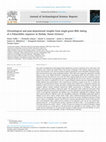
Journal of Archaeological Science: Reports, 2024
Since 2015, the Stelida Naxos Archaeological Project (SNAP) has excavated a prehistoric site on w... more Since 2015, the Stelida Naxos Archaeological Project (SNAP) has excavated a prehistoric site on what today is the northwest coast of Naxos, the largest island of the Cycladic archipelago in the southern Aegean Sea (Greece). Survey and excavations at the site have produced artefacts spanning the Lower Palaeolithic through the Mesolithic periods based on their techno-typological attributes. These discoveries suggest that exploitation of Stelida began as early as the Middle Pleistocene, challenging the long-standing model that the Cyclades were not inhabited until the Early Holocene. Due to the site’s likely temporal depth and the lack of preserved organics, luminescence dating is the most appropriate method to scientifically date this activity. However, luminescence dating in this context is complicated by the site’s complex hillslope formation processes. Experiments upon the Stelida sediments have demonstrated a lack of luminescence sensitivity of quartz at the site. To evaluate the potential for post-depositional mixing of previously acquired dates yielded from a stratigraphic sequence first published in 2019, as well as to evaluate the efficacy of multiple luminescence dating models, we measured and compared different infrared stimulated luminescence [IRSL] measurements on K-feldspars, with IR50 and pIRIR290 multi-grain and pIRIR290 single-grain signals. The single-grain results confirm the multi-grain results and provide additional and more precise information on the site’s depositional and post-depositional events. The results of each approach demonstrate that feldspars were well-bleached, suggesting that in hillslope settings where quartz grains prove difficult to date, IR50 and pIRIR290 multi-grain, and pIRIR290 single-grain signals of feldspars can be used to achieve reliable results. Finally, when considered alongside field and laboratory observations of site stratigraphy, these results suggest that colluvial and aeolian (windblown) deposits at Stelida retain a degree of stratigraphic integrity characterized by minimal post-depositional alteration following their most recent deposition. These support previous estimates of the deposition at the site, the new earliest determination being 233 – 217 thousand years ago [ka], compared to the date of 198.4 ± 14.5 ka published in 2019. These dates represent the earliest – indirect – evidence for open sea crossings in the northern hemisphere, though it remains uncertain as to which species of the genus Homo was responsible for such maritime activity. These results also have implications for the preservation potential of similar deposits across the hillslope, as well as deposits preserved in similar geomorphic settings in Mediterranean landscapes.
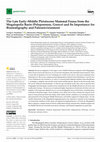
Recent investigations in the upper Lower–Middle Pleistocene deposits of the Megalopolis Basin (Gr... more Recent investigations in the upper Lower–Middle Pleistocene deposits of the Megalopolis Basin (Greece) led to the discovery of several sites/findspots with abundant faunal material. Here, we provide an updated overview including new results on the micro- and macro-mammal fauna. Important new discoveries comprise partial hippopotamus skeletons from Marathousa 1 and the new Lower Pleistocene site Choremi 6, as well as a second partial elephant skeleton from Mara-thousa 1, including a complete tusk and the rarely found stylohyoideum. Based on the first results from the newly collected micromammals, we discuss age constraints of the sites, and we provide biostratigraphic/biochronologic remarks on key mammal taxa for the Middle Pleistocene of Greece and southeastern Europe. The presence of mammals highly dependent on freshwater for their survival, together with temperate-adapted ones in several stratigraphic layers of the basin, including those correlated with glacial stages, when conditions were colder and/or drier, indicate the capacity of the basin to retain perennial freshwater bodies under milder climatic conditions, even during the harsher glacial periods of the European Middle Pleistocene, and further support its refugial status. Yet, the smaller dimensions of the Megalopolis hippopotamuses may represent a response to the changing environmental conditions of the epoch, not optimal for hippopotamuses. Overall, the Megalopolis Basin comprises a unique fossil record for southeastern Europe and provides valuable insights into the Middle Pleistocene terrestrial ecosystems of Europe, and hominin adaptations in particular.
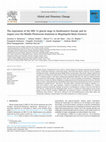
Journal of Archaeological Science, 2024
Southern Europe is hypothesized to have acted as a glacial refugium for hominin populations durin... more Southern Europe is hypothesized to have acted as a glacial refugium for hominin populations during the Pleistocene. Of particular importance is SouthEast Europe, which most likely played a dual role, both as refugium and dispersal corridor, especially during the Middle Pleistocene glaciations, when drastic climatic conditions led to major sea level drops in the Aegean. However, little is known about the palaeoenvironmental conditions at the time of hominin presence in this region, making these hypotheses difficult to test. Here we analyze biomarker data and leaf wax stable isotopic compositions of the MIS 12 Lower Palaeolithic site Marathousa 1 (Megalopolis Basin, Greece) to assess the climatic conditions accompanying the time of hominin presence in the area. Our data indicate a major cooling affecting the north Mediterranean/Aegean domain during this time interval, with lowest temperatures recorded between~440-432 ka. The glacial peak is associated with changes in vegetation (i.e., from more forested to more open landscape), reduction of humidity and water availability (i.e., moisture depletion, increased evaporation). Hominins are present at the Marathousa 1 location at the end of this interval (434-432 ka), confirming that the Megalopolis Basin served as a refugium for hunter-gatherer groups during periods of harsh climatic conditions. Additionally, the progressive cooling is associated with an important sedimentary hiatus between~465-440 ka reflected in all circum-Mediterranean records (both marine and continental), indicating a regional impact of the MIS 12 glaciation over surface processes.

Following the discovery and excavation of the Lower Palaeolithic butchering locality Marathousa 1... more Following the discovery and excavation of the Lower Palaeolithic butchering locality Marathousa 1 (MAR-1; Megalopolis Basin,<br> Peloponnesus, Greece), conducted by the Ephoreia of Paleoanthropology and Speleology, Greek Ministry of Culture in collaboration with the American School of Classical Studies at Athens, led to the discovery of a new open-air locality, Marathousa 2<br> (MAR-2), approximately 1.5 km eastern of MAR-1, where stratified fossils were identified on a profile of the Marathousa Member<br> (Choremi Formation), directly below the Lignite Unit III of the Marathousa mine. Two areas were designated, both yielding so far<br> mainly hippopotamid bones: Area A with (cervical and thoracic) vertebrae and ribs belonging to a single individual of Hippopotamus,<br> as well as a mandibular fragment of a fallow deer (Dama sp.), and Area B, about 90 m NW, with isolated dental Hippopotamus<br> specimens. The fossils in both areas occur in the sam...
Umhlatuzana rockshelter is known for its continuous record of Middle and Later Stone Age lithic a... more Umhlatuzana rockshelter is known for its continuous record of Middle and Later Stone Age lithic assemblages. This study presents multiproxy geoarchaeological data (micromorphology, X-ray diffraction and scanning electron microscopy with energydispersive spectroscopy) to reconstruct the depositional and post-depositional history of the site. Although the Stone Age deposits macroscopically appear Geoarchaeology. 2023;1-26. wileyonlinelibrary.com/journal/gea | 1 This is an open access article under the terms of the Creative Commons Attribution License, which permits use, distribution and reproduction in any medium, provided the original work is properly cited.
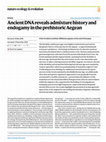
The Neolithic and Bronze Ages were highly transformative periods for
the genetic history of Europ... more The Neolithic and Bronze Ages were highly transformative periods for
the genetic history of Europe but for the Aegean—a region fundamental
to Europe’s prehistory—the biological dimensions of cultural transitions
have been elucidated only to a limited extent so far. We have analysed newly
generated genome-wide data from 102 ancient individuals from Crete, the
Greek mainland and the Aegean Islands, spanning from the Neolithic to
the Iron Age. We found that the early farmers from Crete shared the same
ancestry as other contemporaneous Neolithic Aegeans. In contrast, the end of the Neolithic period and the following Early Bronze Age were marked by ‘eastern’ gene flow, which was predominantly of Anatolian origin in Crete.
Confirming previous findings for additional Central/Eastern European
ancestry in the Greek mainland by the Middle Bronze Age, we additionally
show that such genetic signatures appeared in Crete gradually from the
seventeenth to twelfth centuries bc, a period when the influence of the
mainland over the island intensified. Biological and cultural connectedness within the Aegean is also supported by the finding of consanguineous
endogamy practiced at high frequencies, unprecedented in the global
ancient DNA record. Our results highlight the potential of archaeogenomic
approaches in the Aegean for unravelling the interplay of genetic admixture, marital and other cultural practices.
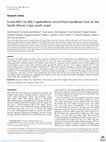
We present new stable oxygen and carbon isotope composite records (δ 18 O, δ 13 C) of speleothems... more We present new stable oxygen and carbon isotope composite records (δ 18 O, δ 13 C) of speleothems from Sandkraal Cave 1 (SK1) on the South African south coast for the time interval between 104 and 18 ka (with a hiatus between 48 and 41 ka). Statistical comparisons using kernel-based correlation analyses and semblance analyses based on continuous wavelet transforms inform the relationships of the new speleothem records to other proxies and their changes through time. Between 105 and ∼70 ka, changes of speleothem δ 18 O values at SK1 are likely related to rainfall seasonality. Variations of δ 13 C values are associated with changes of vegetation density, prior carbonate precipitation (PCP), CO 2 degassing in the cave, and possibly variations of the abundance of C 3 and C 4 grasses in the vegetation. The relationships of δ 18 O with other proxies shift between ∼70 and 48 ka (Marine Isotope Stages 4-3) so that both stable isotope records now reflect CO 2 degassing, evaporation, and PCP. Similar relationships also continue after the hiatus for the deposition phase between 42 and 18 ka. Our findings support modeling results suggesting drier conditions in the study area when the Southern Hemisphere westerlies are shifted north and the paleo-Agulhas Plain is exposed.
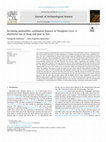
The chemical diagenesis and palaeoenvironmental reconstruction of the Palaeolithic sequence of Th... more The chemical diagenesis and palaeoenvironmental reconstruction of the Palaeolithic sequence of Theopetra Cave have been studied extensively, but little information is available regarding the details of its combustion structures. The cave is characterized by extensive beds of multi-sequence combustion layers dated between 140 and 50 ka BP, and thick, often stratigraphically complex bodies of ash and charred remains dated between 16 and 13 ka BP. All combustion features contain large amounts of charred and partially charred fibrous organic matter of non-wood plant material and very little charcoal. The structure, fabric, composition, and chemistry of these remains suggest that a mixture of peat and dung was used as a fuel, occasionally enriched with amounts of wood fuel. The integrity of the sequence of combustion structures precludes the possibility that dung was produced by animals inside the cave as their traffic on its wet substrate would have destroyed the burnt layers and homogenized the sediment. The mixture of peat and dung was most likely collected from peatlands associated with swamps of the former so called Karditsa Lake that probably existed in the area until the beginning of the Holocene. Peat and dung were used as a fuel when wood fuel was not available, during the relatively cold intervals of the glacial periods, but also during the last interglacial when the area close to the cave was wooded. Of great interest is that this same fuel was used during both the Middle and the Upper Palaeolithic, presumably by different human species. Although Theopetra appears to be the first site that peat and dung was used as a fuel during the Middle Palaeolithic, it is suggested that other sites may have used this fuel as well. This has important consequences in understanding the evolution of human pyrotechnology particularly during glacial periods.

Marathousa 2: A New Middle Pleistocene Locality • 35 and indirect lines of evidence have their ow... more Marathousa 2: A New Middle Pleistocene Locality • 35 and indirect lines of evidence have their own limitations. Most importantly, cut marks are relatively rarely preserved on megafaunal bones (e.g., due to their thick cartilage and periosteum), while subsequent action of biotic (e.g., carnivores) and abiotic agents (e.g., weathering, water transport) may modify or even eliminate the original, anthropogenic bone surface modifications (e.g., Haynes and Klimowicz, 2015; Pineda et al., 2019). Furthermore, the stratigraphic association of megafaunal and cultural remains does not imply de facto the hominin exploitation of the carcasses, and their causal association requires taphonomic analysis (e.g., Giusti, 2021). In this article, we provide evidence for hippopotamus exploitation by hominins at the new Middle Pleistocene locality Marathousa 2 in the Megalopolis Basin (southern Greece). Our aim is to contribute to the understanding of Middle Pleistocene hominin subsistence behavior, with emphasis on megafauna procurement, as well as to enrich our knowledge on Homo-Hippopotamus interactions in the Paleolithic, which are still meager in the European record. A preliminary announcement of Marathousa 2 was presented in Konidaris et al. (2019). Here, we provide elaborated and updated data about the locality, stratigraphy, fauna, and taphonomy, and we discuss the paleoenvironmental context of the locality based on the first results from the ongoing study on mollusks from the Megalopolis Basin (Boni, 2022; Boni et al., in prep.). THE MEGALOPOLIS BASIN AND PREVIOUS RECENT RESEARCH The Megalopolis area (Arcadia, Peloponnesus, Greece; Figure 1a) is an intramontane basin, which was filled by fluviolacustrine deposits from the late Neogene onwards. Dur-36 • PaleoAnthropology 2023:1
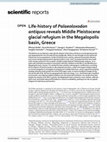
The Balkans are considered a major glacial refugium where flora and fauna survived glacial period... more The Balkans are considered a major glacial refugium where flora and fauna survived glacial periods and repopulated the rest of Europe during interglacials. While it is also thought to have harboured Pleistocene human populations, evidence linking human activity, paleoenvironmental indicators and a secure temporal placement to glacial periods is scant. Here, we present the first intra-tooth multi-isotope analysis for the European straight-tusked elephant Palaeoloxodon antiquus, on an adult male individual excavated in association with lithic artefacts at the MIS 12 site Marathousa 1 (Megalopolis basin, Greece). The studied find also exhibits anthropogenic modifications, providing direct evidence of hominin presence. We employed strontium, carbon and oxygen isotope analysis on enamel bioapatite to investigate its foraging and mobility behaviour, using a sequential sampling strategy along the tooth growth axis of the third upper molar, to assess ecological changes during the last decade of life. We found a geographically restricted range, in a C 3-dominated open woodland environment, and relatively stable conditions over the examined timeframe. Our results show that, despite the severity of the MIS 12 glacial, the Megalopolis basin sustained a mesic habitat, sufficient plant cover and limited seasonal fluctuations in resource availability, pointing to its role as a glacial refugium for both fauna and hominins.
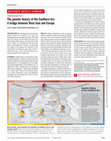
By sequencing 727 ancient individuals from the Southern Arc (Anatolia and its neighbors in Southe... more By sequencing 727 ancient individuals from the Southern Arc (Anatolia and its neighbors in Southeastern Europe and West Asia) over 10,000 years, we contextualize its Chalcolithic period and Bronze Age (about 5000 to 1000 BCE), when extensive gene flow entangled it with the Eurasian steppe. Two streams of migration transmitted Caucasus and Anatolian/Levantine ancestry northward, and the Yamnaya pastoralists, formed on the steppe, then spread southward into the Balkans and across the Caucasus into Armenia, where they left numerous patrilineal descendants. Anatolia was transformed by intra-West Asian gene flow, with negligible impact of the later Yamnaya migrations. This contrasts with all other regions where Indo-European languages were spoken, suggesting that the homeland of the Indo-Anatolian language family was in West Asia, with only secondary dispersals of non-Anatolian Indo-Europeans from the steppe.
We present the first ancient DNA data from the Pre-Pottery Neolithic of Mesopotamia (Southeastern... more We present the first ancient DNA data from the Pre-Pottery Neolithic of Mesopotamia (Southeastern Turkey and Northern Iraq), Cyprus, and the Northwestern Zagros, along with the first data from Neolithic Armenia. We show that these and neighboring populations were formed through admixture of pre-Neolithic sources related to Anatolian, Caucasus, and Levantine hunter-gatherers, forming a Neolithic continuum of ancestry mirroring the geography of West Asia. By analyzing Pre-Pottery and Pottery Neolithic populations of Anatolia, we show that the former were derived from admixture between Mesopotamian-related and local Epipaleolithic-related sources, but the latter experienced additional Levantine-related gene flow, thus documenting at least two pulses of migration from the Fertile Crescent heartland to the early farmers of Anatolia.
Hesperia, 2022
The circumstances of the discovery, stratigraphy, and construction of the grave of the Griffin Wa... more The circumstances of the discovery, stratigraphy, and construction of the grave of the Griffin Warrior were described briefly in 2016 as an introduction to a detailed presentation of the four gold rings found inside it. Here the "life history" of the grave is considered fully. As a sealed context, the grave of the Griffin Warrior also provides a key dated context for many classes of artifact, the chronologies of which have not hitherto been well defined. Because of its importance in this regard, supporting evidence is presented that the Griffin Warrior was buried in Late Helladic IIA and that the burial deposit in the grave lay undisturbed after Late Helladic IIA.
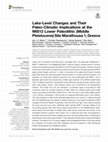
Frontiers in Earth Science, 2021
Lithics and cut-marked mammal bones, excavated from the paleo-lake Marathousa 1 (MAR-1) sediments... more Lithics and cut-marked mammal bones, excavated from the paleo-lake Marathousa 1 (MAR-1) sediments in the Megalopolis Basin, southern Greece, indicate traces of hominin activity occurring along a paleo-shoreline ca. 444,000 years (444 ka) ago. However, the local environment and climatic conditions promoting hominin activity in the area during the MIS12 glacial remain largely unknown. In order to reconstruct the paleo-environment including paleo-lake levels and governing paleo-climatic factors on a high temporal resolution, we
analyzed a 6-meter-long sediment sequence from the archeological site MAR-1 and a Bayesian age model was computed for a better age constrain of the different sedimentary units. A multiproxy approach was applied using ostracods, sponge spicules, diatoms, grain sizes, total organic carbon, total inorganic carbon and conventional X-ray fluorescence analysis. The results from the site represent a protected region surrounded by high mountains under the constant influence of water, either as a shallow partly anoxic water body surrounded by reed belts (>463–457 ka, <434–427 ka), a riverine-lake deltaic system
(∼457–448 ka), a floodplain (∼448–444 ka) or a seasonal freshwater pond (∼444–436 ka). The local changes of water levels resemble large trends and rhythms of regional records from the Mediterranean and appear to directly respond to sea surface temperature (SST)
changes of the North Atlantic. In particular, when the SSTs are high, more moisture reaches the study area and vice versa. Additional water reaches MAR-1 through melting of the surrounding glaciers after brief warm phases during MIS12 in the Mediterranean realm, which leads to the formation of smaller fresh water ponds, where also the horizon of the excavated remains is placed. Such ponds, rich in ostracods and other microorganisms, provided mammals and humans valuable resources, such as potable water, a wide range of plant species and hunting opportunities. These deposits therefore bear a high archeological potential. The results from our study suggest that the Megalopolis Basin could have served as a refugium for hominins and other organisms due to its capacity to retain freshwater bodies during glacial and interglacial periods.
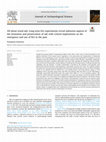
Journal of Archaeological Science, 2021
Despite the growing number of experimental studies of fire, there is still a lack of critical inf... more Despite the growing number of experimental studies of fire, there is still a lack of critical information on the physical alteration of ash remains and its importance in the preservation and interpretation of combustion features in the archaeological record. This study presents an 8-year long experimental investigation of several hundreds of open fires and laboratory experiments and the analysis of their chemistry, mineralogy, morphology, and physical parameters. Important observations have been made regarding ash weathering, charcoal production, post-fire use of heated ashes, and the influence of kindling and soil organic matter on thermal alteration and reddening of the fire substrate. A wealth of information is provided on the formation of ash minerals, their physical and chemical alteration with temperature, and post-fire reactions with water. The resulting evidence can explain the recent geo-ethnoarchaeological observations that ephemeral open-air fires are likely to disappear if they are not quickly buried by sediment by a non-eroding process. Ash formed during a single or a few relighting events is extremely porous (more than 90% total porosity), light (less than 0.2 g/cm 3 bulk density), and highly compressible (about 90%) under the weight of foot traffic or 1.5 m of overburden sediment. This makes ash remains extremely vulnerable to modification in an open environment and macroscopically invisible in an excavation, even in the absence of the slightest post-depositional chemical alteration. Ash remains become progressively more sintered as relighting events increase, thus producing a crusted less porous and more stable formation. Nevertheless, remains of a 5 cm-thick unaltered ash buried in a sedimentary sequence will most likely represent several tens of fires made in the same area whereas a flat 20 cm-thick ash sequence represents hundreds of fire events on top of one another. These results are of extreme importance in evaluating the emergence and use of fire in the Pleistocene and they also provide a better understanding and interpretation of ash remains in later periods. Finally, it is suggested that only a multimethod research strategy can reveal the necessary information to understand and correctly interpret archaeological ash remains.
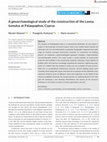
Geoarchaeology, 2021
The tumulus of Palaepaphos-Laona is a monumental earthwork. Its size makes it unique in the lands... more The tumulus of Palaepaphos-Laona is a monumental earthwork. Its size makes it unique in the landscape of ancient Cyprus, where even smaller burial mounds are extremely rare. It is characterized by a composite stratigraphic sequence and a wide range of carefully arranged construction materials. To reconstruct the building process, we employed a geoarchaeological approach, including a high-resolution microstratigraphic analysis. The study reveals a careful selection of construction materials and variability in the construction methods, reflecting a long tradition of building skills and empirical knowledge regarding the materials' engineering properties. It is evident that the tumulus of Laona was not a product of earth accumulation but an accomplished architectural structure. Several building stages were recorded, which along with repairs and intervals of exposure of the sediments, they represent temporal cycles of different nature and magnitude. As the height of the structure gradually increased, the tumulus became an imposing physical mark that gave the landscape a new meaning. Nevertheless, the memory of the ancestral testimony it was meant to convey to future generations was lost.
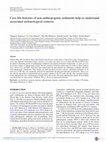
Quaternary Research, 2021
Pinnacle Point (PP) near Mossel Bay in the Western Cape Province, South Africa, is known for a se... more Pinnacle Point (PP) near Mossel Bay in the Western Cape Province, South Africa, is known for a series of archaeological caves with important archaeological finds. Extensive excavations and studies in two of them (PP13B and PP5-6) have documented alternating periods of anthropogenic-dominated and geogenic-dominated sedimentation. A variety of caves do not bear evidence of anthropogenic remains. We have studied in detail the remnant deposits of three of them, Staircase Cave, Crevice Cave, and PP29, which have been formed under the same geologic and sedimentary conditions with those with anthropogenic contributions. Their remains are small and patchy but have extensive speleothem formations (as do most caves at PP) that were isotopically analyzed for paleoclimate and paleoenvironmental reconstruction. These caves also offer the opportunity to understand the purely geogenic signature of the PP locality and thus offer a geogenic baseline for the anthropogenic caves. Archaeologists normally focus only on sites with strong anthropogenic signals, but by building cave life histories we "raise the bar" (Goldberg 2008, p. 30) on our contextual knowledge.
Science Advances, 2019
We present evidence of Middle Pleistocene activity in the central Aegean Basin at the chert extra... more We present evidence of Middle Pleistocene activity in the central Aegean Basin at the chert extraction and reduction complex of Stelida (Naxos, Greece). Luminescence dating places ~9000 artifacts in a stratigraphic sequence from ~13 to 200 thousand years ago (ka ago). These artifacts include Mousterian products, which arguably provide first evidence for Neanderthals in the region. This dated material attests to a much earlier history of regional exploration than previously believed, opening the possibility of alternative routes into Southeast Europe from Anatolia (and Africa) for (i) hominins, potentially during sea level lowstands (e.g., Marine Isotope Stage 8) permitting terrestrial crossings across the Aegean, and (ii) Homo sapiens of the Early Upper Paleolithic (Aurignacian), conceivably by sea.
Microstratigraphic and mineralogical study of a Late Bronze Age updraft pottery kiln, Kolonna site, Aegina Island, Greece, 2019









Uploads
Papers by Panagiotis Karkanas
the genetic history of Europe but for the Aegean—a region fundamental
to Europe’s prehistory—the biological dimensions of cultural transitions
have been elucidated only to a limited extent so far. We have analysed newly
generated genome-wide data from 102 ancient individuals from Crete, the
Greek mainland and the Aegean Islands, spanning from the Neolithic to
the Iron Age. We found that the early farmers from Crete shared the same
ancestry as other contemporaneous Neolithic Aegeans. In contrast, the end of the Neolithic period and the following Early Bronze Age were marked by ‘eastern’ gene flow, which was predominantly of Anatolian origin in Crete.
Confirming previous findings for additional Central/Eastern European
ancestry in the Greek mainland by the Middle Bronze Age, we additionally
show that such genetic signatures appeared in Crete gradually from the
seventeenth to twelfth centuries bc, a period when the influence of the
mainland over the island intensified. Biological and cultural connectedness within the Aegean is also supported by the finding of consanguineous
endogamy practiced at high frequencies, unprecedented in the global
ancient DNA record. Our results highlight the potential of archaeogenomic
approaches in the Aegean for unravelling the interplay of genetic admixture, marital and other cultural practices.
analyzed a 6-meter-long sediment sequence from the archeological site MAR-1 and a Bayesian age model was computed for a better age constrain of the different sedimentary units. A multiproxy approach was applied using ostracods, sponge spicules, diatoms, grain sizes, total organic carbon, total inorganic carbon and conventional X-ray fluorescence analysis. The results from the site represent a protected region surrounded by high mountains under the constant influence of water, either as a shallow partly anoxic water body surrounded by reed belts (>463–457 ka, <434–427 ka), a riverine-lake deltaic system
(∼457–448 ka), a floodplain (∼448–444 ka) or a seasonal freshwater pond (∼444–436 ka). The local changes of water levels resemble large trends and rhythms of regional records from the Mediterranean and appear to directly respond to sea surface temperature (SST)
changes of the North Atlantic. In particular, when the SSTs are high, more moisture reaches the study area and vice versa. Additional water reaches MAR-1 through melting of the surrounding glaciers after brief warm phases during MIS12 in the Mediterranean realm, which leads to the formation of smaller fresh water ponds, where also the horizon of the excavated remains is placed. Such ponds, rich in ostracods and other microorganisms, provided mammals and humans valuable resources, such as potable water, a wide range of plant species and hunting opportunities. These deposits therefore bear a high archeological potential. The results from our study suggest that the Megalopolis Basin could have served as a refugium for hominins and other organisms due to its capacity to retain freshwater bodies during glacial and interglacial periods.
the genetic history of Europe but for the Aegean—a region fundamental
to Europe’s prehistory—the biological dimensions of cultural transitions
have been elucidated only to a limited extent so far. We have analysed newly
generated genome-wide data from 102 ancient individuals from Crete, the
Greek mainland and the Aegean Islands, spanning from the Neolithic to
the Iron Age. We found that the early farmers from Crete shared the same
ancestry as other contemporaneous Neolithic Aegeans. In contrast, the end of the Neolithic period and the following Early Bronze Age were marked by ‘eastern’ gene flow, which was predominantly of Anatolian origin in Crete.
Confirming previous findings for additional Central/Eastern European
ancestry in the Greek mainland by the Middle Bronze Age, we additionally
show that such genetic signatures appeared in Crete gradually from the
seventeenth to twelfth centuries bc, a period when the influence of the
mainland over the island intensified. Biological and cultural connectedness within the Aegean is also supported by the finding of consanguineous
endogamy practiced at high frequencies, unprecedented in the global
ancient DNA record. Our results highlight the potential of archaeogenomic
approaches in the Aegean for unravelling the interplay of genetic admixture, marital and other cultural practices.
analyzed a 6-meter-long sediment sequence from the archeological site MAR-1 and a Bayesian age model was computed for a better age constrain of the different sedimentary units. A multiproxy approach was applied using ostracods, sponge spicules, diatoms, grain sizes, total organic carbon, total inorganic carbon and conventional X-ray fluorescence analysis. The results from the site represent a protected region surrounded by high mountains under the constant influence of water, either as a shallow partly anoxic water body surrounded by reed belts (>463–457 ka, <434–427 ka), a riverine-lake deltaic system
(∼457–448 ka), a floodplain (∼448–444 ka) or a seasonal freshwater pond (∼444–436 ka). The local changes of water levels resemble large trends and rhythms of regional records from the Mediterranean and appear to directly respond to sea surface temperature (SST)
changes of the North Atlantic. In particular, when the SSTs are high, more moisture reaches the study area and vice versa. Additional water reaches MAR-1 through melting of the surrounding glaciers after brief warm phases during MIS12 in the Mediterranean realm, which leads to the formation of smaller fresh water ponds, where also the horizon of the excavated remains is placed. Such ponds, rich in ostracods and other microorganisms, provided mammals and humans valuable resources, such as potable water, a wide range of plant species and hunting opportunities. These deposits therefore bear a high archeological potential. The results from our study suggest that the Megalopolis Basin could have served as a refugium for hominins and other organisms due to its capacity to retain freshwater bodies during glacial and interglacial periods.
As a sealed, single-component, archaeological site, the Neolithic settlement complex of Alepotrypa Cave is one of the richest sites in Greece and Europe in terms of number of artifacts, preservation of biological materials, volume of undisturbed deposits, and horizontal exposure of archaeological surfaces of past human activity and this publication is an important contribution to ongoing archaeological research of the Neolithic Age in Greece in particular, but also in Anatolia, the Balkans and Europe in general.
This edited volume offers a full scholarly interdisciplinary study and interpretation of the results of approximately 40 years of excavation and analysis. It includes numerous chemical analyses and a much needed long series of radiocarbon dates, the corresponding microstratigraphic, stratigraphic and ceramic sequence, the human burials, stone and bone tools, faunal and floral remains, isotopic analyses, specific locations of human activities and ceremonies inside the cave, as well as a site description and the history of the excavation conducted by G. Papathanassopoulos.
The primary aim of the conference is to make a contribution to the ongoing debate concerning the form and content of interdisciplinary research on human-environment dynamics in past societies from prehistory to Late Antiquity. The conference will be an arena for innovative ideas, integrated methods and lessons learnt from current interdisciplinary projects in the Peloponnese and beyond. In answer to the open call for more collaborative research efforts, the conference will host 17 lectures by members of the PELOPS group and invited speakers, presenting well integrated accounts of human-environment interactions in past societies.
The conference will open on Thursday, 6 April, 2017, 7 pm at the Acropolis museum, with a lecture by Michael GIVEN (University of Glasgow), ‘Conviviality of the land: towards a new academic ecology’, followed by a welcome reception at the Swedish Institute at Athens.
The conference will thereafter take place at the American School of Classical Studies at Athens, 7-8 April, 9 am-18 pm.